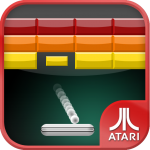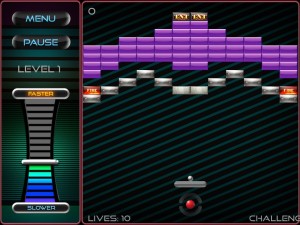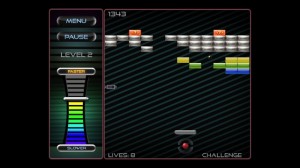 At its core, Breakout is one of the simplest games you can play. For anyone who is unsure which classic game it is, it’s the one with the bat at the bottom and the breakable bricks at the top of the screen. Its Pong but your opponent is replaced by a half screen of little blocks that you chip away at with your bouncing ball of doom.
At its core, Breakout is one of the simplest games you can play. For anyone who is unsure which classic game it is, it’s the one with the bat at the bottom and the breakable bricks at the top of the screen. Its Pong but your opponent is replaced by a half screen of little blocks that you chip away at with your bouncing ball of doom.
While it was the influence for many later games like Arkanoid that layered on story and crazy enemies, basic Breakout is one of the oldest and most pared-back gaming experiences you can play today. The joy of Breakout is that just like some of the very best classic games like Tetris or Pac Man, it is still fun to play today. The simplicity of Breakout also makes it one of the very first games that games programmers try to replicate when they learn how to make games.
To differentiate a Breakout game in the competitive iOS market is difficult, but this one holds a different appeal; it is the official Atari version. This badge of authenticity is enough to make interested gamers check out this particular version.
 There are some nice additions to the formula made to Breakout Boost, but there is an initial point that needs to be made: this game is based on the micro transaction model. Although you can play the fist few levels of the game for free, this amounts to little more than a demo and this means you need to spend some money if you want the full experience. The good news is that these “updates” are all cheap and well worth the small amount that you pay to unlock them.
There are some nice additions to the formula made to Breakout Boost, but there is an initial point that needs to be made: this game is based on the micro transaction model. Although you can play the fist few levels of the game for free, this amounts to little more than a demo and this means you need to spend some money if you want the full experience. The good news is that these “updates” are all cheap and well worth the small amount that you pay to unlock them.
One of the big additions to the game is the speed slider on the left hand side of the screen. This can speed up or slow down the game speed. This introduces a nice little risk reward mechanic, as speeding up the game increases your score but slowing it down makes it easier to make sure you don’t lose a life.
The different modes that you can buy mix up the gameplay in simple but interesting ways. Standard series power ups like multi-ball and exploding blocks appear, and they are used in interesting, well laid out levels.
Crucially, the controls work well and the developer has taken care to make sure that the control method doesn’t involve obscuring the screen with your finger. The touch screen control method works far better than it would in a game that requires a virtual D-pad and I seldom felt like any lives I lost were the fault of the control method rather than my own carelessness.
 The visuals are very functional but perfectly serve the gameplay. Excessive graphical spectacle would have been misplaced in a game that tries to be faithful to the original, and the simple and clear visuals evoke the original while glossing over what would now be an ugly game. Meanwhile, the menu music is painful but the in-game sound effects are pleasingly retro.
The visuals are very functional but perfectly serve the gameplay. Excessive graphical spectacle would have been misplaced in a game that tries to be faithful to the original, and the simple and clear visuals evoke the original while glossing over what would now be an ugly game. Meanwhile, the menu music is painful but the in-game sound effects are pleasingly retro.
If you’re looking for a revolutionary redesign of Breakout in the same way as something like Pac Man DX then this probably isn’t radical enough for you. If however you love the fundamental gameplay of Breakout, this is probably the best choice on an iOS device
7 balls are bounding out of 10
